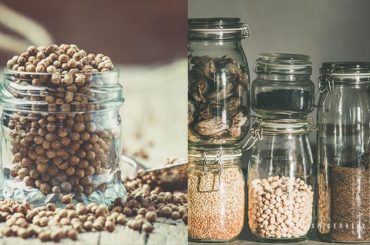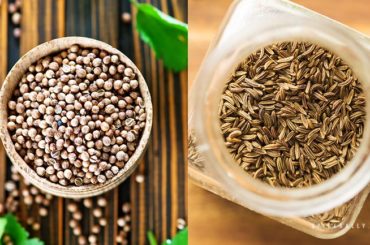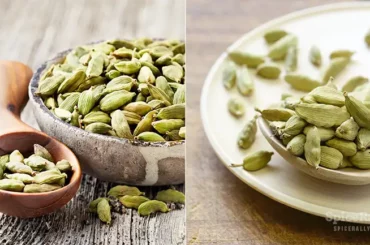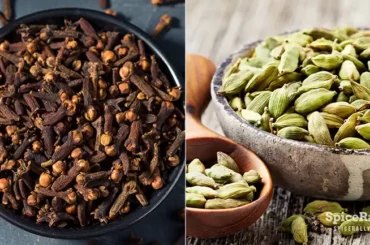You will agree at once if we say that the most confusing herbs in the world of culinary are coriander leaves (cilantro) and parsley. They look so similar that one would even end up buying parsley instead of coriander leaves or vice versa. That is why we wanted to address the actual differences and similarities of coriander vs parsley.
Parsley and coriander come from the same botanical family but with different flavors, scent profiles, and a few other subtle differences. Though they look similar, when checked closely, we can find that they are slightly different in appearance too.
So, you will learn everything you need to know about coriander vs parsley by the end of this article. Make sure you pay attention to each and every detail of this feature to get the best from this.
Coriander Vs Parsley- What’s The Real Difference?
Parsley and coriander leaves (cilantro) are both well-known culinary herbs used to flavor and aromatize food. They are also used for various other medicinal purposes from the days of yore.

They look so similar that we often get confused when purchasing. But, when examined closely, we can find a slight difference in their appearance. Coriander and parsley are also very distinct in flavor and aroma. In fact, Coriander leaves (cilantro) have a sharper, intense taste and smell than parsley.
However, in this article, we intend to focus more on regular or flat-leaf parsley since it is the one that most of us get confused with coriander leaves. Unlike coriander, parsley does not produce seeds that could be incorporated into culinary use.
There are a lot more details that we should look into. So, make use of the table below to learn each and every difference and similarity between coriander and parsley.
| Coriander | Parsley | |
|---|---|---|
| Flavor Profile | Citrusy, nuanced, and intense with a fresh bite. (Soapy tasting to some) | Has a vegetal flavor, with bright, peppery, herbaceous, and bitter undertones |
| Fragrance Profile | Somewhat citrusy, earthy, refreshing (soapy smelling to some) | Has a gentle grassy and earthy smell when crushed. |
| Forms used and availability | Mostly available as fresh leaves and stalks but also could be bought as a dried herb. | Used and available as fresh leaves or as a dried herb. |
| Dishes or food that pair well | Rice dishes Soups Salsa Salad dressings Fresh salads Stir-fries Avocado Bell pepper Coconut milk Corn Cucumber Figs Yogurt Carrots Potatoes Stews Root vegetables Chutneys Sauces Lime Dips Oil infusions | Sauces Rice dishes Soups Dips Pestos Dips Pasta dishes Spaghetti dishes Meatballs Sausage dishes Salads Lamb Pork Beef Chicken Fish Seafood Salad dressings Vegetable dishes Hummus Potatoes Eggs Tomatoes Lemon Lentils Casseroles |
| Culinary use | A herb Best for with slow cooking Used chopped As a garnish | A herb As a sprinkle As a garnish Used chopped |
| Nutrition per 100g | 23 calories 2.13 g of protein 3.67g of carbohydrates 0.52 fat | 36 calories 3 g of protein 6g of carbohydrates 0.8g of fat |
| Health benefits | – Helpful for digestive issues – Eases nausea – Reduces blood sugar – Improves heart health – Supports cognitive function and brain-rated health issues. – Possible advantages in the absorption of heavy metals of mercury-laden foods. – Safeguards against Candida and Salmonella. | – Beneficial for high blood pressure – Treats allergies – Rich in antioxidants like flavonoids, carotenoids, and vitamin C – Reduces the risk of certain cancer types like colon cancer and lung cancer – It treats diabetes and helps to regulate blood sugar – Provides protection against chronic diseases – Rich in Vitamin K that supports with strengthening the bones and bone-building – Provides eye protection improving vision, and prevents age-related macular degeneration – Contains anti-bacterial properties – It prevents the growth of Salmonella and Listeria bacteria |
| Availability | Readily available in both dried and fresh forms in leading supermarkets, local grocers, and online sellers. | Broadly available as fresh leaves and a dried herb in mainstream supermarkets, grocery stores, and online shopping sites. |
| Price | – A fresh bunch of cilantro costs about $0.96 – A 0.4 oz dried cilantro container costs around $4 | – A bunch of fresh parsley cost about $0.98 (both flat-leaf and curled parsley) – A container of 2.7 ounces of dried parsley costs around $5.48 |
| Shelf life | Fresh cilantro stays crisp for about 7-10 days when properly stored and refrigerated. Dried cilantro stays flavorful for about 1-3 years. | Fresh parsley would stay nice and crisp for up to 7 to 10 days when properly stored and refrigerated. Dried parsley will have a shelf life of up to 2-3 years when stored correctly in an air-tight container. |
| Main featuring cuisines | Asian, North African, European, Middle Eastern. | Europen, Middle Eastern, Italian, French, Western Asian, and American cuisines. |
| Appearance | Lacy, flat green leaves with long and tender stalks. | Flat-leaf parsley is bright green, feathery, lacy, and flat. Curled-leaf parley is bright green, tender, and curled or deeply frilled. |
| The Harvesting | Coriander plant is trimmed about one-third down from the top, and the remaining two-third is kept to grow new leaves. | When the leaf stems have three segments, parsley is prepared to be harvested. Leaves are trimmed from the exterior portions of the plant whenever required, and the inner part of the plant is left to be matured. |
| Scientific name | Coriandrum sativum | Petroselinum crispum |
| Plant Family | Apiaceae | Apiaceae |
| Other names | – Cilantro – Chinese parsley – Dhania | There are three types of parsley. Regular parsley used in cooking is also called garden parsley, flat-leaf parsley, or Italian parsley. And, the other two are Curled-leaf parsley or Italian parsley (used in garnishing) and Hamburg parsley. |
| Origin | Not exactly identified. | Originated from Central and Eastern Mediterranean regions. |
| Coriander | Parsley |
What Are Coriander Leaves (Cilantro)?
Coriander leaves (cilantro) come from the Coriandrum sativum plant and fall under culinary herbs. Leaves of this plant are popular among the American cuisine as cilantro, while the other countries call them coriander or coriander leaves.
The seeds of the coriander plant are a spice and are a staple in many dishes made in countries across the world. Interestingly, all the four parts of this plant- seeds, roots, leaves, and stalks are edible and included in many tasty recipes to give a unique taste.
What Is Parsley?
Parsley comes from the biennial or perennial aromatic plant Petroselinum crispum. It belongs to the same plant family as coriander, dill, fennel, etc.
There are three different types of parsley belonging into three cultivar groups. If in case you are not very familiar with all of them, remember that all these three varieties are taken into culinary use. The three types include the following:
- Regular parsley – Also called flat-leaf parsley, garden parsley, or Italian parsley. It has flat leaves like coriander and is the most common, aromatic, and flavorsome type used in cooking.
- Curled-leaf parsley – Also called French parsley. This type is not usually used in cooking but is the most common type used in garnishing or sprinkling. The leaves of this variety are curled and prettier than falt-leaf parsley. It is considered a tasteless herb which makes it a reason to be only used with garnishing.
- Hamburg parsley – This type is also called root parsley which is surprisingly not a herb. In fact, this is a root vegetable that is extensively used in Eastern European, British, US, and Central European cuisines. It produces a thick root that can be included in stews and soups and even enjoyed as a light snack. Root parsley is often confused with parsnips, but they both are different in taste.
Is Coriander The Same As Flat-Leaf Parsley?
As we have presented to you through the table above, you clearly see that parsley and coriander leaves (cilantro) are two different herbs, although they belong to the same family.
We don’t blame you if you ever get this question since we all tend to get baffled by their incredible similarity. Unlike curled-leaf parsley, flat-leaf parsley shows an intimate resemblance to coriander leaves. But if you observe carefully, you can find slight differences between coriander and flat-leaf parsley.
Flat-leaf parsley has a bright, green-yellow hue and a more pointed zigzag shape of the leaves.
While in contrast, cilantro (coriander leaves) are a flat-leaf herb with a three-lobed configuration. The ends of the leaves have a jagged formation that is not as pointed as flat-leaved parsley and tend to be more globular. Moreover, they are more deeply green colored more inclined to the hue of emerald green.
Can I Use Parsley Instead Of Coriander Leaves (Cilantro) And Vice Versa?
Coriander leaves (cilantro) and parsley both are herbs that are widely used in dishes across the world. And, both of them are marked for their unique flavors, aroma, and texture.
However, due to their close resemblance and since they share the same family bond, you might think if they could replace each other. Well, on the lucky note, the answer is yes! If you ever run out of any of these herbs and have just one in hand, you can go ahead and replace one another.
It’s a comfort to always find pasta in the cupboard and garlic and parsley in the garden
Alice Waters
But, remember, just because you make a substitution, that does not mean that coriander could give the same flavor as parsley and vice versa. In fact, coriander leaves are considered to have a more robust, sharper flavor and aroma than parley. An also, due to to a chemical compound in coriander leaves, some even say they taste like dish soap. You will not experience this in parsley (which is a good thing!).
On the other hand, curled-leaf parsley is much blander and comes with less aroma, typically used only in sprinkling or as a beautiful embellishment in dishes. So, you have to keep in mind that this type of parsley will not be a good substitute for the places you intend to replace cilantro (coriander leaves)
However, you can still use flat-leaf parsley in the same way that you use coriander leaves (cilantro), and it goes the same way the other way round. You can replace dried coriander with dried parsley and fresh coriander leaves (cilantro) with fresh parsley and vise versa.
Usage In Cooking- Coriander Vs Parsley
Parsley and coriander leaves mainly feature plenty of delicious dishes from European and Middle Eastern cuisines.
These herbs act as a garnish and as an additive in the last-minute cooking process. However, as mentioned above, unlike coriander or flat-leaf parsley, curled leaf parsley is not generally going into meals expecting to get flavor and aroma. It is just used as a garnish in many dishes.
When added to high-heat simmering food, these two herbs tend to wilt and lose flavor. Consequently, most of the time, both of them are incorporated with slow-cooked dishes or added at the end of the cooking process.
Coriander leaves do not only compete with parsley but also with celery leaves. For more sophisticated information, just tap here, and we will direct you to an exclusive feature.
How To Pair Coriander Leaves (Cilantro) and Parsley With Other Herbs and Spices?
Coriander leaves are intensely flavored than parsley, and thus, if you want a delicate herbal flavor, parsley would be your best bet. But, that doesn’t mean cilantro overpowers the taste of a particular dish. It will combine well with other herbs, spices, and ingredients to enhance the flavor and texture.
Basil, cilantro, chives, garlic, mint, oregano, rosemary, and tarragon are the elements that perfectly match parsley. At the same time, basil, chives, dill, garlic, ginger, lemongrass, mint, parsley pair well with coriander leaves.
Parsley is a star in many North American, Italian, European, and Middle Eastern sauces, pasta, egg, and soup recipes. At the same time, coriander features in Indian, Mexican, and Middle Eastern cuisines. It is used in many salsas, biryani, chutney, and guacamole recipes.
Before Ending The Confusion-Clearance Of Coriander Vs Parsley…
Coriander leaves (cilantro) and parsley, close to each other and share the same family, are two flavorful and aromatic herbs that add so much herbal value to your food.
Even though they look the same and come from the same botanical family, they do have some differences. And, this article was all about to help you identify the differences and similarities between coriander vs parsley and give you knowledge on what to use when.
So, we believe that we are successful with our attempt. And, we hope that you will not have any future confusion when choosing these two herbs.




